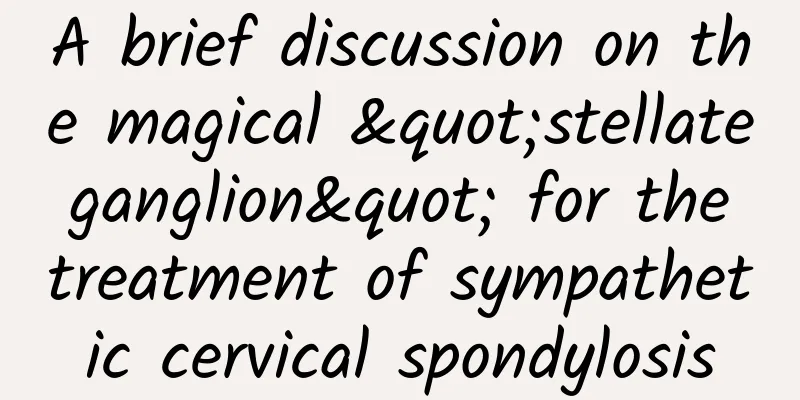A brief discussion on the magical "stellate ganglion" for the treatment of sympathetic cervical spondylosis

|
In recent years, the number of people suffering from cervical spondylosis has been increasing year by year, which may be related to the popularization of computers, the accelerated pace of society, and the long hours of "head-down tribe" working at their desks. When you experience occipital pain, dizziness, tinnitus, blurred vision, anxiety, depression, memory and cognitive disorder, and pseudo-angina, you need to be alert to the possibility of sympathetic cervical spondylosis. Ms. Wang, 36 years old, is a mother who has suffered from neck and shoulder pain for more than a year. She just gave birth to her second child two months ago. Recently, her neck and shoulder pain has worsened, as well as paroxysmal chest pain, accompanied by dizziness, palpitations, chest tightness, and occasional nausea. The fatigue of taking care of the child for two months made her even more worried and anxious. Her family was worried that she had "postpartum depression". She visited several clinics of our hospital and underwent a series of examinations on the brain, cervical spine, heart, etc., but no obvious abnormalities were found. The effect of psychological counseling and drug treatment was not significant. Finally, she was introduced by a cardiologist to come to the outpatient clinic of Director Zhang Zhili of the Pain Department of Qinhuangdao First Hospital. After a careful physical examination by Director Zhang and combined with previous auxiliary examinations, other internal medicine diseases were ruled out and sympathetic cervical spondylosis was considered. Sympathetic cervical spondylosis is a series of clinical symptoms caused by various structural lesions of the cervical spine stimulating the sympathetic nerves, including occipital pain, nystagmus when the head moves, tinnitus, blurred vision, and corneal hyperesthesia. Other symptoms include anxiety, depression, and memory and cognitive disorders. Because the affected parts are extremely complex, it is extremely difficult to diagnose clinically and needs to be differentiated from a series of internal medicine diseases. It is also a disease that is easily misdiagnosed clinically. After research, Director Zhang Zhili's team diagnosed Ms. Wang with sympathetic cervical spondylosis. The first step of the treatment plan was to perform ultrasound-guided stellate ganglion block. Stellate ganglion block is a minimally invasive treatment method commonly used in the pain department. It is a reversible block of the sympathetic nerves that control the head, face, neck, upper limbs and upper chest by injecting local anesthetics and other drugs into the loose connective tissue containing the stellate ganglion. The operation is simple and easy to perform with ultrasound guidance. It has the advantages of correctly selecting the puncture point, shortening the puncture time, accurately controlling the depth of the needle, improving the success rate of puncture, and avoiding blind puncture and damage to adjacent important organs. It not only improves the success rate but also reduces complications. The sign of successful blockade is the occurrence of Horner syndrome, which is manifested as pupil constriction, ptosis, sunken eyeballs, nasal congestion, conjunctival congestion, slightly red face, and no sweat on the face. After several treatments, Ms. Wang's symptoms such as neck and shoulder pain, chest pain and tightness, palpitations, and restlessness were basically relieved. In the second step, in order to consolidate and maintain the treatment effect, Ms. Wang received "green" neuromodulation treatment of pulsed high-voltage radiofrequency modulation of the stellate ganglion under ultrasound guidance. Pulsed radiofrequency is a neuromodulation technology that uses pulsed current below 42°C on the target nerves to avoid dependence on temperature damage and prevent nerve damage. This method can effectively improve the patient's vertebral artery blood flow and clinical symptoms and reduce the patient's pain level. After treatment, the symptoms that had troubled Ms. Wang for a long time were finally relieved, and she was discharged from the hospital with satisfaction! The magical stellate ganglion block is not only an effective treatment for sympathetic cervical spondylosis, but also has a wide range of applications and significant effects, including: 1. Systemic diseases: autonomic dysfunction, insomnia, hyperhidrosis, vertigo, skin itching, post-stroke pain, post-herpetic pain, chronic fatigue syndrome, phantom limb pain, diabetes, etc. 2. Head and facial diseases: migraine, tension headache, cerebral thrombosis, cerebral vasospasm, cerebral infarction, nerve paralysis, atypical facial pain, etc. 3. Eye and ENT diseases: floaters, visual fatigue, allergic rhinitis, Meniere's disease, benign paroxysmal vertigo, tinnitus, etc. 5. Respiratory and circulatory system diseases: angina pectoris, sinus tachycardia, cardiac neurosis, chronic bronchitis, pulmonary embolism, bronchial asthma, etc. 6. Digestive system diseases: ulcerative colitis, gastritis, gastric ulcer, intestinal obstruction, constipation, diarrhea, etc. 7. Urogenital system diseases: abnormal menstruation, premenstrual tension, menopausal syndrome, neurogenic urinary frequency, nocturia, urinary incontinence, prostatitis, etc. 8. Diseases of the body and limbs: cervical spondylosis, cervical-shoulder-arm syndrome, periarthritis of the shoulder, redness, swelling and pain in the extremities, cyanosis, thromboangiitis obliterans, bone hyperplasia, degenerative osteoarthritis, low back pain, etc. It should be noted that stellate ganglion block is risky and requires evaluation by an experienced pain specialist before it can be performed. Pain is a disease. Pain specialists specialize in treating various intractable pains that are not effectively treated by other departments. They analyze the causes and mechanisms of pain, provide medication, nerve block therapy, various nerve regulation and nerve destruction and other minimally invasive interventional surgeries, and provide psychological intervention when necessary. Through comprehensive treatment, symptoms are effectively relieved and the quality of life is improved! |
<<: Which is more serious, gallstones or gallbladder polyps?
>>: Peking Union Medical College doctor says | How should children get the flu vaccine?
Recommend
Ptosis can lead to decreased vision!
Eyelids are located in front of the eyeball and a...
The pregnant woman almost fainted. What happened?
It is normal for pregnant women to feel dizzy occ...
What to do if you have back pain during early pregnancy
I believe everyone is familiar with the symptom o...
Night Listening | Eating dinner earlier vs. later, the difference is so big!
Hello, this is Science Popularization China. We o...
What medicine should women take for acute urethritis
For women's normal life, it is often seriousl...
Is it normal for latex pillows to have odor? How to get rid of the odor of latex pillows?
With the improvement of the quality of life, more...
The safest way to abort a miscarriage
Things in the world usually have at least two opp...
How to deal with fever when preparing for pregnancy
Nowadays, many people like to have a planned life...
5 reasons why women’s breasts can’t grow bigger
First: Insufficient protein intake The weight los...
I'm vomiting acid three months into my pregnancy
Acid reflux symptoms are often caused by reflux e...
Treatment for darkening and enlargement of areola during pregnancy
We all know that life is very difficult for every...
What is the cause of coffee-colored discharge from the vagina?
Under normal circumstances, vaginal secretions ar...
Absence of menstruation and lower abdominal distension
Some people should pay more attention if they hav...
What comic is the Korean drama Memorist based on? Where can I read the Memorist comic?
The Korean drama Memorist, starring Yoo Seung-ho ...









